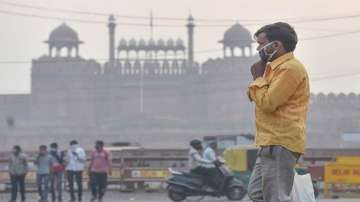Delhi-NCR's air quality hits 'emergency' levels
A grey apocalyptic smog enveloped Delhi on Tuesday, blotting out the sun from the sky and smudging landmarks from view as the city's air quality hit "emergency" levels.

A grey apocalyptic smog enveloped Delhi on Tuesday, blotting out the sun from the sky and smudging landmarks from view as the city's air quality hit "emergency" levels.
Delhi recorded a 24-hour average air quality index (AQI) of 476, which falls in the "severe" category. The neighbouring cities of Faridabad (448), Ghaziabad (444), Noida (455), Greater Noida (436) and Gurgaon (427), which fall in the National Capital Region (NCR), also recorded "severe" air quality.
It was the sixth "severe" air day on the trot in Delhi. The city witnessed seven "severe" air days in November last year.
The levels of PM2.5 -- which is about three per cent the diameter of a human hair and can lead to premature deaths from heart and lung diseases -- were 494 µg/m3 at 5 pm, more than eight times the safe limit of 60 µg/m3.
The PM10 levels stood at 600 micrograms per cubic metre (µg/m3) at 5 pm, according to Central Pollution Control Board (CPCB) data. PM10 levels below 100 µg/m3 are considered safe in India.
According to the Graded Response Action Plan (GRAP), the air quality is considered to be in the "severe plus" or "emergency" category if the PM2.
5 and PM10 levels persist above 300 µg/m3 and 500 µg/m3 respectively for more than 48 hours.
The GRAP recommends measures such as a ban on construction activities and entry of trucks, and a car-rationing scheme in such a scenario.
In the morning, the air quality monitoring stations at Mandir Marg, Punjabi Bagh, Pusa, Rohini, Patparganj, Jawaharlal Nehru Stadium, Najafgarh, Sri Aurobindo Marg and Okhla Phase 2 maxed out as their readings hit the 500-mark, the CPCB data showed.
According to the Delhi Pollution Control Committee (DPCC), the PM10 concentration soared to 1,482 µg/m3 at Bawana, 1,800 µg/m3 at Jahangirpuri, 1,291 µg/m3 at Wazirpur and 1,471 at Punjabi Bagh.
The smog reduced visibility to merely 300 metres in the morning, affecting traffic, an India Meteorological Department (IMD) official said.
The city recorded calm winds and a minimum temperature of 10.7 degrees Celsius on Tuesday morning.
Calm winds and low temperatures trap pollutants close to the ground, while a favourable wind speed helps in their dispersal.
The Commission for Air Quality Management in the National Capital Region and Adjoining Areas tasked the CPCB on Tuesday with operationalising and monitoring GRAP measures till a mechanism is set up by the newly-formed panel.
At a meeting, the commission also decided that in view of the deteriorating air quality in the NCR, there is a need to invoke the GRAP, which has already been notified by the Centre.
A CPCB official said the pollution watchdog will hold a meeting on Wednesday and take appropriate measures.
As the skies hung heavy and acrid over the region, people complained of an itchy throat and watery eyes.
"It is the same every year irrespective of what governments say or do. It feels like doomsday," Gaurav Rathi, a resident of Jangpura, said.
Simran Vyas, a 54-year-old resident of Bhogal, complained of heaviness in the chest and wondered if a lockdown was the only solution to avoid this situation.
Recently, the Indian Medical Association said pollution led to the rise of COVID-19 cases in Delhi by 13 per cent.
According to an online survey with a sample size of 10,500, around 85 per cent households in Delhi, 62 per cent in Gurgaon, 68 per cent in Noida, 43 per cent in Ghaziabad and 66 per cent in Faridabad have "either one or more individuals suffering from pollution-related ailments".
Government agencies and experts said the calm wind speeds are exacerbating the effect of stubble-burning and a "quick recovery" is not possible unless the number of farm fires reduces drastically.
V K Soni, the head of the IMD's environment research centre, said a major improvement in Delhi-NCR's air quality is highly unlikely in the coming days.
"The air quality is likely to be recorded in the upper end of the 'very poor' category on Diwali if we discount firecracker emissions. If people burst crackers, pollution levels can increase to the 'severe' to 'severe plus' (emergency) category," he said.
The Ministry of Earth Sciences' air quality monitor, SAFAR, said the city is witnessing an "unusual" condition and no quick recovery is predicted from the "severe" air pollution.
The central agency said three major factors are responsible for this situation -- secondary particle formation, extremely calm local surface winds and stubble-related intrusion.
It said the farm fire count in Punjab, Haryana, Uttar Pradesh, Uttarakhand and neighbouring areas stood at 2,247.
"The number has marginally reduced but is still significantly high," it said.
The share of stubble burning in Delhi's PM2.5 pollution was 22 per cent on Tuesday.
The National Green Tribunal (NGT) imposed a total ban on Monday on the sale or use of all kinds of firecrackers in the NCR from the midnight of November 9 to the midnight of November 30, saying "celebration by crackers is for happiness and not to celebrate deaths and diseases".